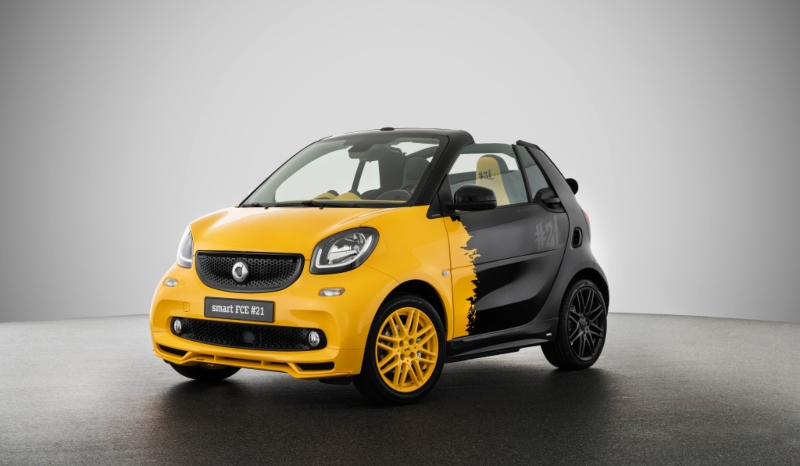In 2020 smart will become the first automotive manufacturer in the world to have uncompromisingly switched its entire portfolio over from combustion engines to electric drives. Before smart goes all-electric next year, the brand is presenting an exclusive and strictly limited special edition of the final #21 combustion-engine vehicles – designed by Konstantin Grcic and for the most ardent collectors only. smart has stood for innovative mobility for more than two decades now. With the Final Collector’s Edition it is marking the beginning of a new era and 21 years of hands-on pioneering spirit.
For the final #21 of their kind, smart is collaborating with internationally renowned industrial designer Konstantin Grcic to create a contemporary work of art for the road while at the same time marking the beginning of a new era in the history of the automobile. The edition centres on the idea of 21 years of smart, 21 vehicles, 21 years always a step ahead. The vehicles of the limited collection, which have been designed by Konstantin Grcic and realised in cooperation with Brabus, will leave the factory in August 2019, offering collectors and true smart fans a unique opportunity to take 21 years of pioneering spirit home with them.
The Final Collector’s Edition – the beginning of a new era
Before smart opens up the electric mobility chapter in earnest, the brand is taking a look in the rear-view mirror with an edition that pays tribute to what made the first smart vehicles with combustion engines so special, as captured in Grcic’s design for the final #21. “#21 commemorates something special, celebrating 21 years of smart. For me, it also symbolises much of what being 21 is about: being free, breaking boundaries, breaking out, showing your rebellious side. The Final Collector’s Edition brings this essential idea to life as we take our leave of a piece of automotive history,” says Konstantin Grcic.
The declared watershed marking the beginning of a new era is embodied in the chosen colour concept and the design as a whole. The colour scheme is also a homage to the first-generation smart: From the brilliant yellow front end through the tag-style #21 marking to the matt black rear. The employed yellow is based on the original colour “hello yellow”, establishing the association with smart’s origins that is so important to the edition. ‘
Reduce to the max’ was the mission statement for the very first vehicles. The idea back then was to cooperate with various artists. Swiss artist Roman Signer, for example, had the car drive through a form of tunnel, at the end of which a bucket of paint was poured over the smart. Grcic’s design for the Final Collector’s Edition, featuring a frazzled transition from yellow to black, also cites part of this history.
A long-standing commitment to electric mobility
In launching the Final Collector’s Edition, smart is staying true to its pioneering role. The smart brand is without parallel in the way it provides automotive answers to the ever-growing urbanisation of our world and offers innovative solutions to make life in the city easier and more attractive. Right at the very outset, visionary Nicolas Hayek considered the possibility of an environment-friendly electric drive for the smart. 100 all-electric smarts were finally delivered in London in 2007. The “electric drive”, Europe’s first series-production electric car, highlighted the company’s innovative prowess and its courage to explore new avenues.
“smart remains much more than a car – it represents the grand vision of a new form of urban mobility. As such, the ground-breaking decision to switch the entire range to electric drives only as of 2020 is a perfectly logical step. For us, the Final Collector’s Edition marks both the end of an era and a new beginning as a significant milestone in the history of smart and towards a future horizon,” notes Daniel Lescow, head of brand and product management at smart, in explanation of the idea behind the final #21.
About Konstantin Grcic
Konstantin Grcic (*1965) learned cabinet making at the John Makepeace School in Dorset, England, before going on to study design at the Royal College of Art in London. In 1991 he established his own design studio in Munich, from where he has since relocated to Berlin. He works in various areas at his studio, from projects in the area of industrial and furniture design through exhibition design to collaborations in the fields of architecture and fashion.
Works by Konstantin Grcic are included in the permanent collections of the world’s leading design museums (including MoMA/New York, Centre Georges Pompidou/Paris). Grcic defines function in a human context and combines an austere approach to design with considerable mental acuity and humour. A profound understanding of design and architecture and a passion for technology and materials inform each one of his works. Well known for items stripped down to their essentials, Grcic is often described as ‘minimalist’, though he himself prefers the term ‘simplicity’.








































